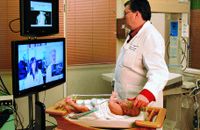Videoconference technology lets doctors examine a baby off-site
Columbus' Nationwide Children's Hospital recently installed a videoconference center for its pediatric department, linking the large hospital to a small town an hour away.

Key Points

Chillicothe previously had been sending more children to Nationwide than any other local hospital. The phone-based consults weren't a good enough substitute for an in-person exam. As a result, almost every phone consult led to a newborn transfer.
Transferring infants from one hospital to another is no mean feat: it costs about $5,000, with another $10,000 or so for a few days' stay. Moreover, it separates the mother and the father from the child during crucial days for breastfeeding and bonding.
The combination of high-quality cameras and widescreen monitors lets a baby's breathing pattern, color, profusion, and birth defects be seen. "It gives really good views of everything," Brown said. "High definition can even show rashes." The set-up allows for digital X-ray images to be displayed on the same screen.
"We're even working on a stethoscope," Brown said. The attachment would let physicians hear a broadcast of an infant's breathing via a microphone in the bell.
A pair of LCD or plasma monitors and top-quality cameras costs about $10,000. "In the realm of medicine, it's not that expensive," Brown said. The Ohio Supercomputer Center (OSC) helped cover the costs, as well as set up the infrastructure.
The pediatric department taught staff members how to use the set-up during weekly meetings. They handle the basic maintenance, and call in the IT professionals from OSC if there's a major malfunction.
Now that it's up and running, the Nationwide staff videoconferences at least once a week. "It helps in the acute situations," Brown said. She's anxious to get other divisions of the hospital involved in the teleconferencing as well. She suggested endocrinology and psychiatry as two departments that could benefit from remote face-to-face meetings with patients.
Eventually, Nationwide's network could be as all-expansive as its name. "Ultimately, we'd want to include everyone," Brown said. That includes other large hospitals, small regional hospitals, large pediatric groups, even small practices. Basically, anyone with a webcam and a sick child. "We could even expand this internationally."
Local practices don't need expensive systems to start a videoconference set-up. Everyday webcams and monitors work, too. They may not show a rash to the detail a pediatric dermatologist would prefer, but they would give the consult firsthand visual information.
Many pediatric practices aren't in easy driving distance of a children's hospital. Set-ups like these close the distance, letting rural children receive the same expert opinions as suburban and city kids.
In the past, Nationwide Children's Hospital sometimes had to turn patients away if all of its pediatric beds were taken. Now the hospital can save beds for those who need it the most.